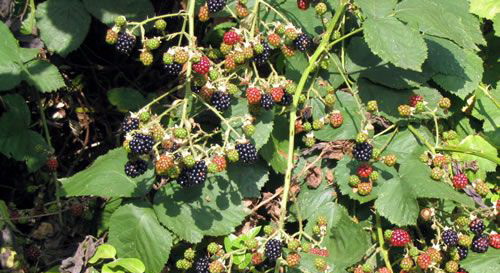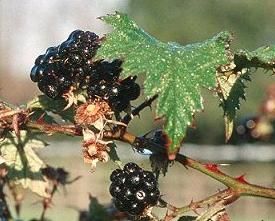
Scientific name: Rubus fructicosus
Appearance: Perennial shrub
Exposure: full sun
Soil: well drained
Description
Often gardeners consider the possibility of escape from cultivation of mulberry prayers. Blackberries are found rarely in stores, but are easily grown and cared for.
Testing of earth and planting blackberry bushes
It is best to test soil pH by about six months before you make planting date, to have enough time to improve the quality of them. If the pH is too low, add dolomite to raise the level to that indicated on the test kit.
Bush roots should be kept moist until planting - either temporarily plant them in another place or keep them wrapped in a wet sleeve. Keep roots blackberry bush in a dry or sun.
Dig a hole large enough roots to spread naturally. Do not short of roots, you can only cut on the broken them. Bush is planted at a depth that was planted in the greenhouse where you purchased it. Crown (which starts from the point of starting stems and roots) should be placed 3 cm below ground level.
After planting, well trodden ground to remove any air holes around the roots. Immediately after planting wet well.
Blackberry bush care
The blackberry is better to be treated with mixtures of fertilizers. For best results, treat bush with fertilizer in early spring when growth begins and again the summer, immediately after harvest.
10.10.10 2 kg of mixed use in a row 30 m long blackberry bush Because to capitalize later, apply fertilizer until the late July to avoid growth of shoots later forced to be affected by winter cold .
In the first two years, during which roots develop completely, spread in about 1 kg of fertilizer around the base of bush, within a radius of 30 cm.
Blackberry bush needs abundant moisture during the ripening of fruits and developed. If it does not rain enough, you need to irrigate the minimum amount of water needed to mature blackberry bushes is 7-8 liters of water per day, during fruit development.
Base covering the plant with straw, sawdust, wood chips or corn cobs help control weeds and retain moisture and nutrients.
Blackberry bushes have carved carefully and often or very well covered with straw that was not overgrown. Once they started to grow, weeds are difficult to control. Digging begins in spring, as soon as soil can be worked and how many times do we need to prevent weeds. Avoid digging very deep, so as not to break the roots. Not digging the earth around the base about a month before the arrival of cold weather (especially frost). The plants already can be used and herbicides.
 Binding, and cutting training
Binding, and cutting training
Blackberry bushes and semi-climbing to be trained on trellises related. Shrubs with straight branches need not be connected if they are cut so that the summer does not exceed 91-120 cm tall, branches can be trained on trellises long wire.
Trellis is built of two poles, stuck in the ground 6 feet distance between them, between which lies wire. For shrubs is pretty straight one wire, caught at 70 cm from the ground, to semi-climbing shrubs using two wires attached respectively to 91 and 150 cm from the ground.
In some varieties of blackberries with straight branches, such as Cherokee and Cheyenne must cut new shoots that give the hub. During the vegetation period is desirable that shoots have no more than 30 cm. When new shoots grow more than that, you have to cut the tips - that will force the lower branch by branch, which will strengthen the wood and bush will be easier to bear fruit weight. During winter, shorten lateral branches up to 30-35 cm from the ground, and late winter cut dry branches.
Once the fruit was picked and last summer, cut all the branches of old, all it is a good time to remove and young shoots that appear fragile.
Blackberry bushes semi-climbing to be trained on trellises as explained above and connected with soft twine.
In general, in the first season harvest will be small. If bush does not grow too much in this first period, cut branches up to 5-10 cm in late winter to force the emergence of more vigorous. For the second year and those to come, vigorous shoots will grow, they must be tied to trellises when have 1.2 to 1.6 meters. Some growers prefer to wait until after harvest all the fruit and cut old branches to tie new shoots. Old branches is cut is a very important operation for disease prevention. After harvest, remove weak or diseased branches and leaving only 4-8 young shoots, they bind to the trellis in a fan shape, not a bunch. Spring shorten any new shoots to 30 cm.
Harvesting
Harvest blackberries with straight branches start about 1-2 weeks after season strawberries, fruit bushes semi-climbing does not begin to ripen than just in the middle of summer. Blackberries are picked when dark.
Propagation
It is a simple operation, even for novice gardeners. The best time is in September, choose a vigorous arm, bend it down (without a break) and a portion of it buried in the ground, a hole about 15 cm. Cover with soil and level. If it seems that the industry will come out, place them over a few rocks that give them a hand in two months, well watered if the environment is very dry.
Cuttings will take root in a few months and can be removed to be planted in the final place in spring next year. To do this, cut the parent shoots approx. 30 cm of new plant and bush unearthed young without too much bother her roots.